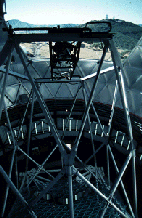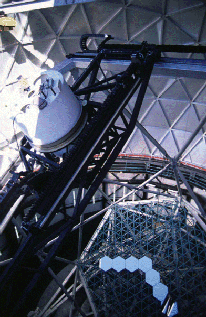HET Technical Overview
(note: this page describes and depicts the HET before the Wide Field Upgrade)
Primary Mirror
 |
The primary mirror is composed of 91 segments, each hexagonal in shape and 1 meter
across. They form a large spherical surface having a radius of curvature of 26.164
meters. Each segment is positioned under computer control to yield a hexagonal primary
mirror 11 meters in diameter with an area of 77.6 square meters.
|
| Primary Mirror Array |
|---|
| Maximum Diameter | 11 meters |
| Area | 77.6 square meters |
| Focal Length | 13.08 meters |
| Filling Factor | ~96.6% |
|
Telescope Structure
 |
The mirror resides within an overall telescope structure that is made of welded steel and
weighs 60 tons. It rotates on air bearings around the complete 360° horizon. It is fixed
in zenith angle at 35° which along with the azimuth rotation allows it to access
declinations from -10°20' to 71°40' (about 70% of the celestial
sky from this latitude, but 81% of the scientifically useful
airmass range < 2.5).
|
Tracking
 |
The HET is a tilted optical Arecibo type telescope, which means that tracking of
astronomical targets is achieved through moving a tracker optical package, which
contains spherical aberration correction optics and instrument feeds, rather than
the whole telescope. Tracking time across the 12° focal surface ranges from 0.75 hr.
at the equator to 2.5 hr. at the north declination limit.
|
 |
| Telescope Parameters |
|---|
| Telescope Tilt Angle | 35° |
| Angular Range (FoV tracker) | 12° |
| Declination Range | -10°20' to 71°40' |
| Site Altitude | ~2 km (6640 ft.) |
|
| Tracker Optical Package |
|---|
| Maximum Diameter | 490 mm |
| Type | Four Element Gregorian |
| Effective F. Ratio (output) | 4.7 |
| Focal Plane FoV | 3.5 arcminutes diameter |
| Final Image Scale | 5 arcseconds/mm |
| Entrance Pupil Diameter (on primary) | 10 meters |
|
|---|
Enclosure and Facility
The HET is located at:
W 104 00 53.0
N 30 40 53.2
2026 meters above the geoid
on the WGS84 system
The HET is housed in a spherical dome 85 feet in diameter and standing 100 feet above
the ground. A 2500 square-foot building houses maintenance and service equipment and the
telescope control room. A 90 foot tower contains an interferometer at the primary mirror
center of curvature which is used to align all the segments in piston, tip
and tilt.
Last updated: Fri, 29 Dec 2023 11:59:27 +0000 stevenj

|
 |

|